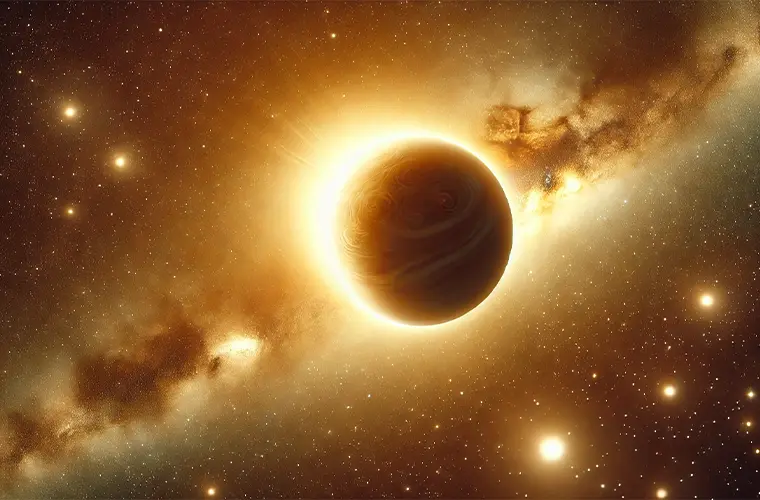A recent study by physicists from the University of Texas at Arlington (UTA) has identified 18 star systems hosting planets that spend part or all of their orbits within the habitable zone around F-type stars—star systems previously overlooked for their potential to support life.
This groundbreaking research opens new avenues in the search for extraterrestrial life and underscores the importance of studying diverse star systems.
“F-type stars are usually considered the high-luminosity end of stars with a serious prospect for allowing an environment for planets favorable for life,” a study co-author, Dr. Manfred Cuntz, explained in a press release by UTA. “However, those stars are often ignored by the scientific community. Although F-type stars have a shorter lifetime than our Sun, they have a wider HZ. In short, F-type stars are not hopeless in the context of astrobiology.”
F-type stars, characterized by their yellowish-white color and surface temperatures exceeding 10,000 degrees Fahrenheit, have long been considered less favorable for life due to their shorter lifespans compared to other star types, such as our Sun.
However, UTA’s team has presented a new view. Despite their relatively short lifespans, F-type stars have wider habitable zones (HZs)—the region around a star where liquid water, essential for life, could exist on a planet’s surface.
“F-type star systems are important and intriguing cases when dealing with habitability due to the larger HZs,” lead author and UTA doctoral student Shaan Patel explained. “HZs are defined as areas in which conditions are right for Earth-type bodies to potentially host exolife.”
The study, published in The Astrophysical Journal Supplement Series, utilized data from the NASA Exoplanet Archive to analyze 206 known F-type star-planet systems. These were then categorized based on how much time the planets spent in the habitable zone.
Results revealed that of these known F-type star systems, 18 planets spend at least part of their orbit within the habitable zone.
These findings mark a significant step forward in understanding the potential for life around different types of stars. The results highlight that F-type stars, once considered too short-lived and too hot for life, may still be viable hosts for life-bearing worlds.
A New Perspective on Habitability Around F-Type Stars
F-type stars are hotter and more massive than our Sun (a G-type star), which means they burn through their nuclear fuel faster, limiting the time available for life to develop.
F-type stars typically have a main-sequence lifetime of only 2 to 8 billion years, compared to the 10-billion-year lifespan of the Sun. As a result, F-type stars were previously considered less likely to host habitable planets. However, the UTA team’s research challenges this assumption.
The study revealed that despite their shorter lifespans, F-type stars possess wider habitable zones—up to four times larger than those of stars like the Sun. This broader habitable zone increases the likelihood that a planet could remain at a suitable distance from the star to support liquid water.
Moreover, F-type stars emit higher levels of ultraviolet (UV) radiation, which, while potentially harmful in large doses, can play a crucial role in kick-starting the chemical reactions necessary for the formation of life.
“Although F-type stars spend considerably less time on the main sequence (MS) than G-, K-, and M-type stars, they still offer a unique set of features, allowing for the principal possibility of exolife,” researchers noted. “Examples of these features include the increased widths of stellar habitable zones as well as the presence of enhanced UV flux, which in moderation may have added to the origin of life in the Universe.”
The researchers considered both circular and elliptical orbits for these planets, finding that planetary eccentricity—the degree to which an orbit deviates from a perfect circle—plays a critical role in determining habitability.
Planets with highly eccentric orbits may pass through the habitable zone for only a portion of their orbit. However, spending only part of an orbit in the habitable zone could still allow for stable climates, particularly if the planet has an atmosphere capable of regulating temperature extremes.
Moreover, the researchers highlight the possibility of habitable exomoons orbiting massive planets within the habitable zones of F-type stars. Most of the planets in the study are gas giants, similar to Jupiter, but they could host moons with conditions suitable for life.
While no Earth-sized planets were identified within the habitable zones of these systems, the team believes future research could uncover smaller, rocky planets or moons with better conditions for life.
HD 111998: A Full-Time Resident of the Habitable Zone
Researchers were able to identify 18 star-planet systems where the planet spends part or all of its orbit within their F-type star’s habitable zone. The most promising of these is HD 111998, also known as 38 Virginis, a planet that orbits its star entirely within the habitable zone.
Located 108 light-years from Earth, HD 111998 is the most promising candidate for further study. While the planet itself may not be habitable due to its large size and gaseous composition, the possibility of habitable moons around HD 111998 cannot be ruled out.
“The planet in question was discovered in 2016 at La Silla, Chile,” Dr. Cuntz explained. “It is a Jupiter-type planet which is unlikely to permit life itself, but it offers the general prospect of habitable exomoons, an active field of worldwide research also pursued here at UTA.”
Gas giants in the habitable zones of their stars are key targets for the search for life beyond Earth because they can host moons with Earth-like conditions.
In our solar system, moons such as Europa and Enceladus, which orbit Jupiter and Saturn, respectively, are considered prime candidates for life due to their subsurface oceans. A similar situation could exist in the HD 111998 system, where exomoons orbiting the gas giant may possess suitable conditions for life.
UTA researchers’ findings expand our understanding of F-type star systems and provide a new direction for future space missions aimed at detecting signs of life beyond our solar system.
Space telescopes like the James Webb Space Telescope (JWST) and proposed missions like the Habitable Worlds Observatory could be used to investigate these systems more closely, searching for Earth-sized planets or potentially habitable moons around gas giants.
One of the study’s key takeaways is the potential for habitability in environments that differ significantly from ours. While Earth’s position in the solar system is often considered the “gold standard” for habitability, this research suggests that life could arise in a wide range of environments, even around stars as hot and short-lived as F-type stars.
As technology advances and our ability to detect and study exoplanets improves, researchers are hopeful that future missions will confirm the existence of habitable worlds in these systems.
“Our work may be useful for future studies, both regarding the possible existence of Earth-mass planets in F-type systems, as well as investigations of possibly habitable exomoons hosted by exo-Jupiters,” researchers concluded. “This latter aspect is highly relevant to F-type systems considering that the lowest-mass planet currently identified in its HZ in those systems has a mass estimate of 143 Earth masses.”
Ultimately, these new findings underscore the need for scientists to cast a broader net in the search for extraterrestrial life. While G-type stars like our Sun remain prime targets, discovering potentially habitable planets and moons around F-type stars offers exciting new possibilities.
With wider habitable zones and the potential for moons to host life, F-type star systems could become increasingly important in astrobiology. As researchers continue to explore these systems, we may find that the universe is more conducive to life than we ever imagined.
“What makes a study like this possible is the hard work and dedication of the worldwide community of astronomers who have discovered more than 5,000 planets over the last 30 years,” study co-author Dr. Nevin N. Weinberg added. “With so many known planets, we can now carry out statistical analyses of even relatively rare systems, such as planets orbiting F-type stars, and identify those that might reside in the habitable zone.”
Tim McMillan is a retired law enforcement executive, investigative reporter and co-founder of The Debrief. His writing typically focuses on defense, national security, the Intelligence Community and topics related to psychology. You can follow Tim on Twitter: @LtTimMcMillan. Tim can be reached by email: tim@thedebrief.org or through encrypted email: LtTimMcMillan@protonmail.com

